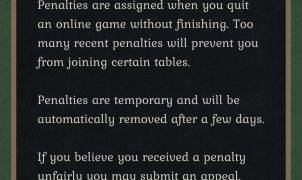In Cutthroat Pinochle, there are no partnerships; it’s every man for themselves. Cutthroat is usually played with three players and can be played with either single deck or double deck. The primary objective it to maximize points for yourself, and the secondary goal is to prevent your opponents from making their bids so they lose points instead of gaining points.
To begin, the dealer shuffles the deck and deals out the entire deck to each player, 3 cards at a time if single deck or 5 cards at a time if double deck. Usually the last 3 cards left get placed face down into the “kitty” in the center of the tables.
Bidding Strategies
After all cards are dealt, players examine their cards and proceed to start the bidding, each player either increasing the bid or passing, until all but the last player passes. The high bidder or last player who doesn’t pass wins the bid.
Every players wants to win the bid so they can choose the trump suit, and have the possibility of improving their hand by picking up the 3 cards in the “kitty” and exchanging them for cards in their hand. However, players must exercise restraint and avoid the temptation to bid higher than the expected points they might achieve from melds and tricks. It is critical to evaluate your hand before bidding and determine your maximum bid based on how many points you estimate your hand will yield. It takes discipline to stop yourself from overbidding and patience to sit back and wait for the right hand to come along. Conversely, if you never bid you’ll never win, and there are times when taking risk will pay off. Striking the right balance between playing conservatively and playing aggressively takes practice.
The first thing to look for when estimating your hand’s worth is how many melds you already have starting out with. If you’re lucky enough to get a run in your initial hand you can probably safely bet up to 30, and might consider going as high as 32. You know that you’ll be guaranteed to get at least 15 meld points and if you play well you should be able to collect at least another 15 points from tricks. There’s a good chance you’ll improve your hand slightly when you pick up the kiddy too. If you have any incidental marriages or a pinochle, it’s safe to increase your maximum bid to 35-40. If you have a double pinochle, go as high 40-45. If you have Aces around, you should be bidding between 25-30. If you have Kings around or Queens around, maybe 20-25. However, if you don’t have any of these things, or just a single marriage or pinochle, you might not want to bid much higher than 20, and it may be best to pass and wait for a better hand to come along.
The next thing to consider is whether or not you’re close to getting a meld, and think about how likely it is you’ll get the card you need from the “kitty”. Are you willing to take a chance? Often this depends on how the game is going and where you stand. If you’re behind your opponents or if the game is almost over, you should definitely take some risk here, otherwise your opponents will leave you in the dust. On the other hand, if you have a comfortable lead it’s probably not worth the risk to lose your hard-earned points by bidding foolishly.
Ask yourself, what if I don’t get the card I need? Do you have enough Aces or trump cards to make up for it in tricks? There are a total of 25 trick points to be had. If you have six or more cards of the same suit and at least 3 or more Aces, you might be able to get between 20-25 trick points if you play well. However, if you don’t have a lot of trump cards or Aces, you may end up with 15 or less.
Choosing Cards from the “Kitty”
Assuming you win the bidding then you get to pick up the “kitty” and hopefully get the card you needed to complete your melds. On the other hand, sometimes you’re not so lucky and the cards don’t help you one way or another. In either case, you’ll need to decide whether or not to keep the cards and which 3 cards to discard.
The first thing you need to decide is what trump you’re going to choose. If you have a run, you’ll have to make the suit of those cards trump to get the 15 meld points. If you don’t have a run but you do have 2 marriages in the same suit, you might consider making that suit trump to get the double marriage points for trump marriages. Otherwise, you probably want to choose the suit in which you have the most cards, and also consider how many Aces or Tens you have in the suit to keep control of the tricks.
Obviously, you don’t want to discard cards that are needed to form your melds. If you have a King and Queen of the same suit, you’ll want to try to hold on to them for the 2 marriage points. If you have Queen of Spades and Jack of Diamonds, you’ll want to keep them for the 4 pinochle points. If you Kings Around or Queens Around, you’ll want to hold on to those. You’ll also want to hold on to your trump Nines as these are worth one point each.
After you’ve identified which cards will earn you meld points, think about your trick-taking strategy. Generally, you’ll want to hold on to your Aces and your trump cards since these will allow you to take the most tricks.
What’s left? Non-trump Nines, non-trump Jacks (unless part of Jacks Around or a pinochle), unpaired, non-trump Kings or Queens (unless part of Kings or Queens Around), and non-trump 10’s. If you discard your Kings or Tens, you’ll get one point each for them. You should strongly consider choosing these to discard unless you have two Aces of the same suit, otherwise it’s likely the points will end up going to your opponents if they end up taking them in a trick. Otherwise, get rid of the three lowest cards left.
Trick-Taking Strategies
In Cutthroat, you want to try to dominate the tricks and take as many as you can for yourself. If you’re the high bidder you get to go first. It’s best to start with your trump Aces as these are guaranteed to win and will draw out any trump cards that your opponents are holding. If you have two trump Aces, then proceed to play any trump Ten’s. However, if you know one of your opponents has a trump Ace, try to save your trump Ten’s until you’re sure both trump Aces have been played, otherwise the points will go to your opponent.
After you play your trump Aces (and possibly Tens), it’s usually good to move on to your non-trump Aces. These usually will win early in the trick-taking unless your opponents have no cards in that suit and take it with a trump.
Next, if you’re holding on to trump 10’s or trump Kings, waiting for your opponents to use any outstanding trump Aces, you can try throwing your lower trump cards, i.e. Nines, Jacks or Queens to try to draw the Ace out. Once you know the trump Aces have been played it’s save to play your Tens. Once you know both trump Tens have been played, it’s safe to play your trump Kings.
A final consideration is that the last trick gets an extra point, so if possible try to save a winning trump card for the end. Get rid of your junk cards in the middle of the hand if you’re confident you can take back control towards the end with your trumps.
When you’re not the high bidder, you’re strategy should be to take as many tricks as you can when the opportunity present, but also to prevent your opponent who is the high bidder from making their bid. When the high bidder throws an Ace or trump card that is most likely to win the trick, try to throw your lowest cards to prevent them from getting trick points. You may consider helping the other opponent by giving them your Kings and Tens when they’re likely to win a trick, thus preventing them from going to the high bidder. If the high bidder opponent has a long way to go to make the bid, you can make them end up losing what they bid if you can steer the pointer cards to the other opponent. However, keep in mind both opponent’s total scores. This strategy is not a good idea when the other opponent is close to winning. In that scenario you may decide to do the opposite and actually help the high bidder.
Conclusion
Cutthroat is great alternative to partners Pinochle when you don’t have four player and many people actually prefer it due to its “cutthroat” nature. It’s fast-paced, exciting and it can be downright ruthless. To practice some of the tips discussed in this article, we highly recommend trying our AI Cutthroat Pinochle game here on this site, or download it from one of Google Play or the Apple App Store.




























































































